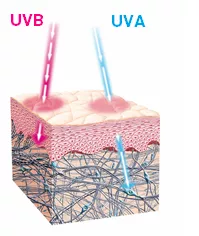Pathway to photoaging
The sun is a vital source of energy. The human knows how to make good use of it.
Sunlight plays a key role in the synthesis of essential biomolecules: melatonin for the synchronization of circadian rhythms, vitamin D needed for the bone function and maintenance, endorphins which affect mood… But excessive sun exposure also leads to detrimental effects, especially on the skin…
80% of extrinsic aging is photoaging
A physical barrier between the inside and the outside, the skin is one of the most responsive organs to external aggressions, particularly to UV (Ultraviolet) radiation. Amongst all environmental factors responsible for extrinsic aging, repeated sun exposure is the most significant (representing 80% of extrinsic aging) and photoaging is the major consequence. Photoaged skins feature a set of typical modifications: wrinkles and fine lines, altered microrelief and coarse skin, lack of luminosity and pigmentary disorders.
About sun rays
For decades, UVB rays have been considered more genotoxic than UVA. They are known to severely damage epidermis, causing local inflammation and sunburns and to penetrate to the heart of cells, down to the DNA. Their role in the generation of photoproducts and direct DNA lesions is clearly established.
Due to its capacity to penetrate deeper layers of the skin, UVA was mainly related to structural alterations of the dermis through the breakdown of collagen and elastin networks amongst others. But today, lots of scientific publications evidenced that UVA radiation is not as innocuous as previously thought.
There are several reasons to report:
- UVA is abundant at the Earth surface: more than 20 times abundant in sun radiation than UVB.
- It penetrates further into the skin, passing the epidermis and reaching the dermis, with damage described on both layers.
- It dramatically increases the oxidative stress level in the skin and generates oxidative DNA lesions.
- Endogenous DNA repair systems are overwhelmed by overexposure to UVA.

More precisely, research show that UVA is very likely to induce DNA lesions in the epidermal basal layer, which hosts the keratinocytes stem cells.
A survival pool for the skin to be protected
The epidermis is a living epithelium, composed of 90% keratinocytes arranged in layers, renewing every 3 weeks on average. The renewal of the epidermis is constant during its lifetime. But only a specific population of keratinocytes can proliferate and initiate the cell renewal process: they are named keratinocyte stem cells.
Commonly speaking, stem cells are the body’s raw materials, present from the embryonic stage of life. This specific type of cell holds the potential to differentiate into multiple cell types and tissues.
In the skin, the keratinocyte stem cells can be considered as the “mother” cells of the epidermis.
The integrity of these epidermal stem cells and their protection against environmental aggressors are absolutely key to ensure the long-term function and health of the epidermis.
In-depth research program
Together with a research group specialized in genotoxic stress, Gattefossé uncovered that although keratinocyte stem cells benefit from very efficient DNA protection and repair systems, they can still be affected by UVA. Indeed, DNA lesions induced by UVA in keratinocytes are associated to a weakening of their self-renewal capacity, their so-called “stemness” potential, ultimately related to functional and structural alterations of the epidermis.

Out of this work, an all-natural active ingredient has been developed and it aims at preserving keratinocytes stem cells from UVA-induced damage.
Stay tuned to know more about this new photoprotective solution by Gattefossé…